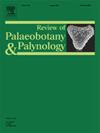希腊莱斯沃斯下中新世松木真菌化石新记录及其古生态意义
IF 1.7
3区 地球科学
Q2 PALEONTOLOGY
引用次数: 0
摘要
希腊莱斯沃斯石化森林中新世沉积物中发现了多种植物化石。越来越多的木化石分类记录为探索该木化石林的化石多样性和古生态意义提供了重要的认识。然而,在这个地区,结构上保存完好的带有真菌残留物的化石植物非常罕见。本文报道了一种新的化石木Lesbosoxylon zourosii sp. nov. Zhu et Wang基于希腊Lesvos中新世Sigri火山碎屑组解剖学上保存完好的化石标本。解剖分析揭示了主要特征,包括轴向和径向树脂管,abietiine和径向点蚀,pinoid交叉场点蚀和三种不同的射线类型。此外,这项调查还记录了保存完好的真菌菌丝的存在,以及木材宿主内的摄食痕迹。这是希腊首次报道与化石木材相关的真菌遗骸。在古生态学上,真菌遗骸被初步解释为一种腐烂真菌,有助于植物物质的分解。Lesbosoxylon zourosii sp. 11 .不仅进一步丰富了Lesvos石化林的化石多样性,而且为早中新世东地中海陆地生态系统植物-真菌相互作用提供了新的证据。本文章由计算机程序翻译,如有差异,请以英文原文为准。
A new record of Lesbosoxylon (Pinaceae) wood with fungal remains from the Lower Miocene of Lesvos, Greece, and its palaeoecological implication
Diverse plant fossils have been reported from the Miocene deposit in the Lesvos Petrified Forest, Greece. Increasing record of fossil wood taxa provide significant understanding for exploring the fossil diversity and palaeoecological implications of this fossil wood forest. However, structurally preserved fossil plants bearing fungal remains are exceptionally rare in this region. Here, we report a new fossil wood Lesbosoxylon zourosii sp. nov. Zhu et Wang based on anatomically well-preserved fossil specimens from the Miocene Sigri Pyroclastic Formation in Lesvos, Greece. Anatomical analysis reveals key features, including axial and radial resin canals, abietinean radial pitting, pinoid cross-field pitting, and three distinct ray types. In addition, this investigation documents the presence of well-preserved fungal hyphae, and feeding traces within the wood host. This represents the first report of fungal remains associated with fossil wood in Greece. Paleoecologically, the fungal remains are tentatively interpreted as a kind of decay fungus, contributing to the decomposition of plant material. Lesbosoxylon zourosii sp. nov. not only further enriches the fossil diversity of the Lesvos Petrified Forest, but also provides new evidence for plant-fungal interaction in the Early Miocene terrestrial ecosystem of the East Mediterranean.
求助全文
通过发布文献求助,成功后即可免费获取论文全文。
去求助
来源期刊
CiteScore
3.50
自引率
21.10%
发文量
149
审稿时长
6 months
期刊介绍:
The Review of Palaeobotany and Palynology is an international journal for articles in all fields of palaeobotany and palynology dealing with all groups, ranging from marine palynomorphs to higher land plants. Original contributions and comprehensive review papers should appeal to an international audience. Typical topics include but are not restricted to systematics, evolution, palaeobiology, palaeoecology, biostratigraphy, biochronology, palaeoclimatology, paleogeography, taphonomy, palaeoenvironmental reconstructions, vegetation history, and practical applications of palaeobotany and palynology, e.g. in coal and petroleum geology and archaeology. The journal especially encourages the publication of articles in which palaeobotany and palynology are applied for solving fundamental geological and biological problems as well as innovative and interdisciplinary approaches.

 求助内容:
求助内容: 应助结果提醒方式:
应助结果提醒方式:


